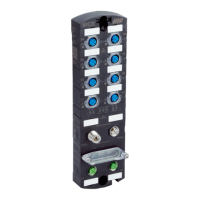and sender (provider). The IO-devices send input data to the controller and receive
output data from it. Other components of the communication protocol are telegrams in
the form of acyclic communication for the transmission of parameters.
Device level ring (DLR)
The communication of the SIG350 is based on a full-duplex Ethernet network with 100
Mbit/s. Auto negotiation is supported.
3.1.2 IO-Link
IO-Link is a standard (IEC 61131-9) that can be used to connect intelligent devices at
the sensor and actuator level to an automation system.
The SIG350 complies with IO-Link specification V1.1.3.
Communication
Communication takes place between a master and a device. An IO-Link Master con‐
tains one or more ports. One device can be connected per port, which means that
IO-Link is point-to-point communication and not a fieldbus. The IO-Link Master forms
the interface between the higher-level fieldbus level and the IO-Link system.
IO-Link is functional and enables advanced diagnostics of sensors and actuators or
simple and fast parameterization through bidirectional communication. The IO-Link
devices are connected to the master via unshielded 3-, 4- or 5-wire standard cables of
a maximum length of 20 m.
The SIG350 supports IO-Link communication at the following speeds:
•
COM 1 → 4,800 baud
•
COM 2 → 28,400 baud
•
COM 3 → 230,400 baud
The module automatically selects the communication speed that matches the IO-Link
device.
IO-Link modus (IOL)
IO-Link communication (C/Q) is activated at pin 4, so an IO-Link device can be con‐
nected.
ISDU (Indexed Service Data Unit) access
The acyclic data allows the device parameters to be written by an IO-Link device or
parameters, measured values and diagnostic data to be read by an IO-Link device.
The following tasks can be performed: • Parameterization/Configuration of an IO-Link
device during operation. • Diagnosis of an IO-Link device by reading out diagnostic
parameters. • Execution of IO-Link port functions. • Saving/Restoring of IO-Link device
parameters. The data on the IO-Link device is uniquely addressed with index and
subindex.
Data storage mode
The data storage mode allows IO-Link devices to be exchanged without any configura‐
tion in the event of service. Both the IO-Link Master and the IO-Link device store the
device parameters. During data storage, these different parameter data memories are
synchronized.
In the event of device replacement, the master writes the stored device parameters
to the new device. The application can be restarted without further intervention via a
configuration tool or the like.
PRODUCT DESCRIPTION 3
8027834./2022-06-10 | SICK O P E R A T I N G I N S T R U C T I O N S | Sensor Integration Gateway - SIG350
9
Subject to change without notice

